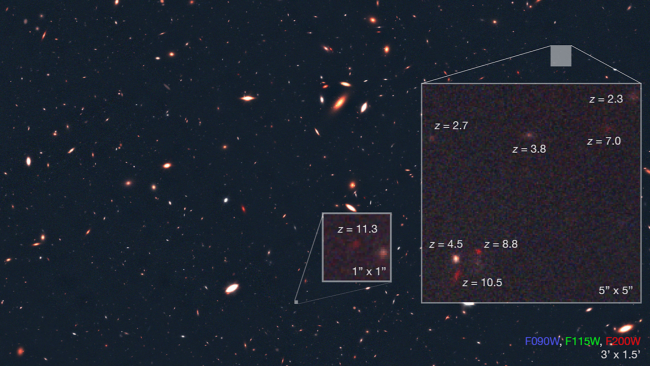James Webb Space Telescope Advanced Deep Extragalactic Survey (JADES)
JADES will use guaranteed time in James Webb Space Telescope (JWST) cycle 1 to produce infrared imaging and spectroscopy of unprecedented depth in the two premier extragalactic deep fields, GOODS-South (CDF-S) and GOODS-North (HDF). These data will reveal the early phases of galaxy formation, probing the rest-frame optical spectroscopy and morphology of galaxies from redshifts 2-3 out to z>10. JADES expects to collect data on about 100,000 galaxies, adding to the extensive legacy of these well-studied fields.

Simulated JWST/NIRCam mosaic generated using JAGUAR and the NIRCam image simulator Guitarra (C. Willmer, in preparation), at the depth of the JADES Deep program. This image is focused on a region of 3’ by 1.5’, and is a composite of the F090W (blue), F115W (green), and F200W (red) filters. The insets show a 5” by 5’ region with multiple high-redshift galaxies, and a 1” by 1” region focused on a galaxy at z = 11.3. Image from Williams et al. (2018, ApJ Supp, 236, 33).
JADES is a collaboration of the JWST Near-Infrared Camera (NIRCam) and Near-Infrared Spectrograph (NIRSpec) instrument teams and will comprise about 800 hours of observing time, with full utilization of coordinated parallels. JADES includes 8-10 filters of NIRCam data over the field, in two tiers of depth. Even the medium depth approaches that of the deepest current data, but over a much wider field. The deep tier will likely set the standard for cycle 1 depth with JWST. Spectroscopy of thousands of galaxies will reveal emission lines down to the faintest limits of the high redshift galaxies as well as kinematics and abundances of intermediate redshift galaxies. Extremely deep parallel observations with the mid-infrared instrument at 7.7 and 12 microns will probe the older stars and hot dust of galaxies at cosmic noon and before. Prof. Daniel Eisenstein serves as the NIRCam Extragalactic Team Lead and proposal PI. The international collaboration of JADES has been actively preparing for the data set and is excited to see the long-anticipated promise of JWST come to fruition in cycle 1.
- What happened in the early universe?
- Why do galaxies differ so much in size, shape, composition and activity?
- Quasars & Other Active Black Holes
- Galaxies - Merging and Interacting
- Galaxy Formation and Evolution